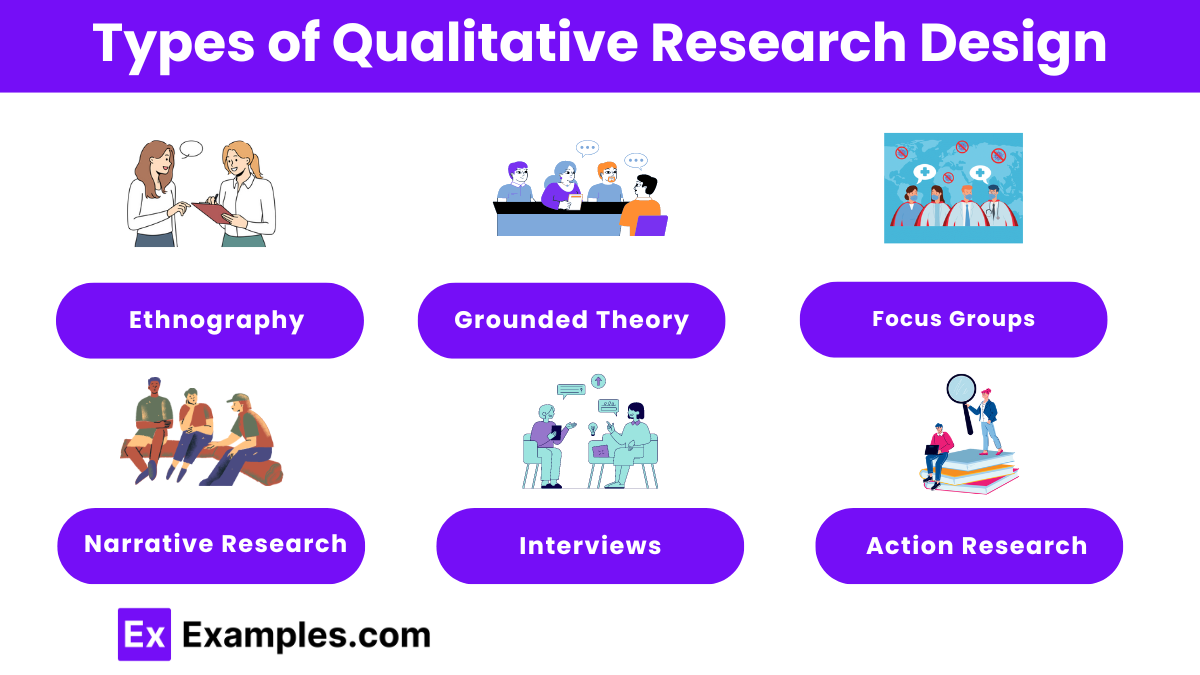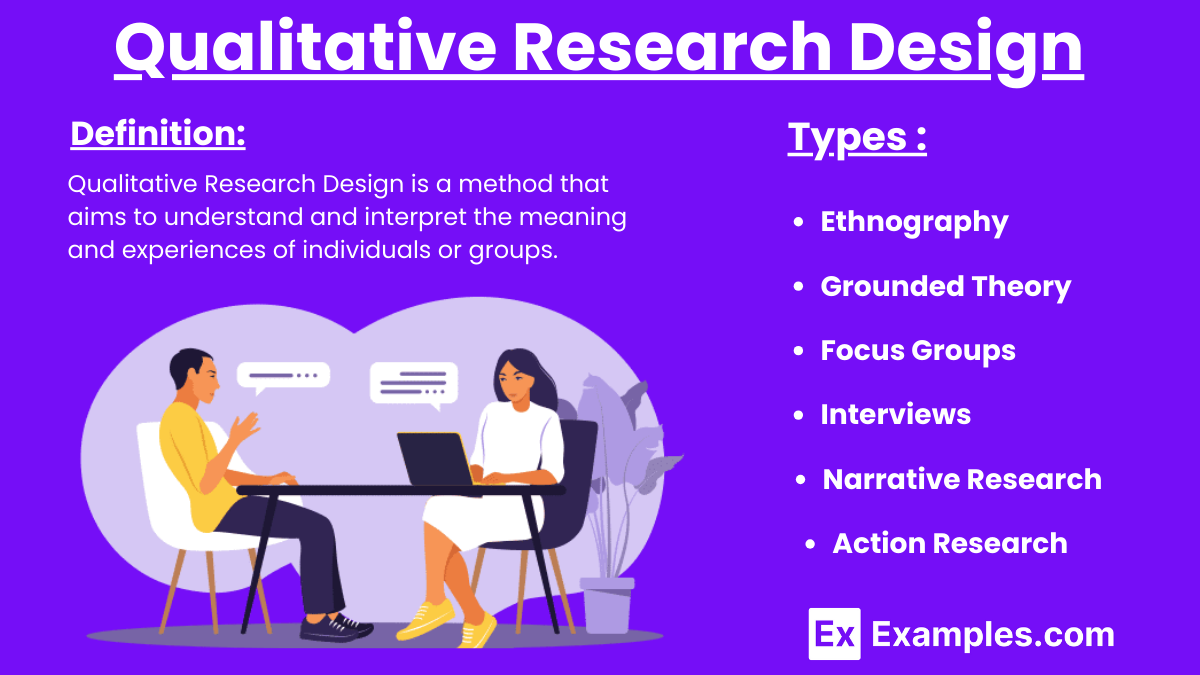10+ Qualitative Research Design Examples
Qualitative Research Design is a method focused on understanding and interpreting the experiences of individuals or groups. Unlike quantitative research, which quantifies data and identifies patterns through statistical analysis, Qualitative Research Design explores phenomena in depth using interviews, focus groups, and observations. This approach gathers rich narratives that provide insights into thoughts, feelings, and behaviors, uncovering underlying reasons and motivations. Essential in fields like social sciences, education, and health, a strong Qualitative Research Proposal or Qualitative Research Plan must carefully consider the Research Design and relevant Research Terms for a comprehensive approach.
What is Qualitative Research Design?
Qualitative Research Design is a method that aims to understand and interpret the meaning and experiences of individuals or groups. It employs in-depth techniques like interviews, focus groups, and observations to gather detailed, rich narratives. Unlike quantitative research, which uses statistical analysis to identify patterns, qualitative research seeks to uncover the underlying reasons and motivations behind thoughts, feelings, and behaviors.
Types of Qualitative Research Design

1. Ethnography
Ethnography involves the detailed study of cultures or social groups through direct observation and participation. Researchers immerse themselves in the group’s daily life to understand their customs, behaviors, and social interactions. This method is often used to study communities, workplaces, or organizations.
Example: Observing and interviewing members of a remote community to understand their social practices and traditions.
2. Grounded Theory
Grounded theory aims to generate a theory grounded in the data collected from participants. Researchers gather data through interviews, observations, and other methods, then use coding techniques to develop a theory. This approach is useful for studying processes, actions, and interactions, such as developing a theory on how people cope with job loss.
Example: Analyzing interviews with employees to develop a theory about workplace motivation.
3. Focus Groups
Focus groups involve guided discussions with a small group of participants to explore their perceptions, opinions, and attitudes towards a particular topic. This method allows researchers to gather a wide range of insights and observe group dynamics. Focus groups are commonly used in market research, social science studies, and product development.
Example: Conducting focus groups with parents to understand their views on remote learning during the COVID-19 pandemic.
4. Interviews
Interviews are one-on-one conversations between the researcher and the participant, designed to gather in-depth information on the participant’s experiences, thoughts, and feelings. Interviews can be structured, semi-structured, or unstructured, allowing flexibility in exploring the research topic. This method is widely used across various qualitative research studies.
Example: Conducting semi-structured interviews with veterans to explore their reintegration experiences into civilian life.
5. Narrative Research
Narrative research focuses on the stories and personal accounts of individuals. Researchers collect narratives through interviews, journals, letters, or autobiographies and analyze them to understand how people make sense of their experiences. This type of research might explore life stories, personal journeys, or historical accounts.
Example: Collecting and analyzing life stories of refugees to understand their migration experiences.
6. Action Research
Action research is a participatory approach that involves researchers and participants working together to address a problem or improve a situation. This method focuses on practical solutions and often includes cycles of planning, action, observation, and reflection. It is commonly used in educational settings to improve teaching practices, school policies, or community development projects.
Example: Teachers working together to implement and assess a new curriculum in their school.
Qualitative Research Design Methods
| Method | Data Collection | Focus | Example |
|---|---|---|---|
| Case Study | Interviews, documents | Single case analysis | Impact of teaching method |
| Ethnography | Participant observation | Cultural understanding | Tribal community practices |
| Grounded Theory | Interviews, observations | Theory development | Coping with chronic illness |
| Phenomenology | In-depth interviews | Lived experiences | Parental grief |
| Narrative Research | Life stories, interviews | Personal narratives | Refugee resettlement stories |
| Focus Groups | Group discussions | Group perspectives | Teenagers’ views on social media |
| Content Analysis | Text, media analysis | Patterns and themes | Media portrayal of mental health |
Interviews
Interviews are one-on-one conversations designed to gather in-depth information about a participant’s experiences, thoughts, and feelings. They can be structured, semi-structured, or unstructured, allowing flexibility in exploring topics.
Example: Semi-structured interviews with veterans to explore their reintegration experiences into civilian life.
Focus Groups
Focus groups involve guided discussions with small groups to explore their perceptions, opinions, and attitudes on a topic. This method gathers diverse insights and observes group dynamics.
Example: Focus groups with parents to understand their views on remote learning during the COVID-19 pandemic.
Observational Studies
Observational studies involve systematically watching and recording behaviors and interactions in natural settings without interference.
Example: Observing children in a playground to study social development and peer relationships.
Discussion Boards
Discussion boards are online forums where participants post responses and engage in discussions. This method collects data from participants in different locations over time.
Example: Analyzing posts on a discussion board for chronic illness patients to understand their coping strategies and support systems.
Difference between Qualitative Research vs. Quantitative Research
| Aspect | Qualitative Research | Quantitative Research |
|---|---|---|
| Definition | Explores phenomena through non-numerical data, focusing on understanding meanings, experiences, and concepts. | Investigates phenomena through numerical data, focusing on measuring and quantifying variables. |
| Data Collection Methods | Interviews, focus groups, observations, document analysis. | Surveys, experiments, questionnaires, existing statistical data. |
| Data Type | Non-numerical, descriptive data (words, images, objects). | Numerical data (numbers, statistics). |
| Analysis | Thematic analysis, content analysis, narrative analysis. | Statistical analysis, mathematical modeling. |
| Purpose | Gain in-depth insights and understand complexities of human behavior and social phenomena. | Test hypotheses, measure variables, and determine relationships or effects. |
| Examples | Studying cultural practices, exploring personal experiences, understanding social interactions. | Examining the effectiveness of a new drug, analyzing survey results, studying demographic trends. |
| Strengths | – Provides detailed and rich data. – Captures participants’ perspectives and context. – Flexible and adaptive to new findings. | – Allows for hypothesis testing. – Results can be generalized to larger populations. – Can establish patterns and predict outcomes. |
Characteristics of Qualitative Research Design
- Naturalistic Inquiry: Conducted in natural settings where participants experience the issue or phenomenon under study.
- Contextual Understanding: Emphasizes understanding the cultural, social, and historical contexts of participants.
- Participant Perspectives: Prioritizes the views, feelings, and interpretations of participants.
- Flexibility and Adaptiveness: Designs are flexible and can be adjusted as new insights emerge.
- Rich, Descriptive Data: Collects detailed data in words, images, and objects for comprehensive understanding.
- Inductive Approach: Develops theories and patterns from the data collected rather than testing predefined theories.
- Emergent Design: Research design evolves during the study based on emerging themes and insights.
- Multiple Data Sources: Uses various data sources like interviews, focus groups, observations, and document analysis.
- Subjectivity and Reflexivity: Researchers acknowledge their influence on the research process and examine their biases and assumptions.
- Holistic Perspective: Considers the entire phenomenon and its complexity, looking at interrelated components.
- Iterative Process: Data collection and analysis occur simultaneously in an iterative manner.
- Ethical Considerations: Ensures informed consent, confidentiality, and sensitivity to participants’ needs and well-being.
- Detailed Reporting: Results are reported in a detailed narrative style, often using direct quotes from participants.
How to Find Qualitative Research Design
1. Identify the Research Problem
Define the specific problem or phenomenon you want to study. For example, you might explore the experiences of first-generation college students.
2. Conduct a Literature Review
Review existing research to understand what has been studied and identify gaps. This helps to build a foundation for your research.
3. Formulate Research Questions
Create open-ended questions to guide your study. Example: “What challenges do first-generation college students face?”
4. Choose a Qualitative Research Approach
Select a methodology that fits your research question, such as phenomenology, grounded theory, ethnography, case study, or narrative research.
5. Select the Research Setting
Decide where you will conduct your study, such as a university campus or online forums relevant to your topic.
6. Identify and Recruit Participants
Determine criteria for participant selection and recruit individuals who meet these criteria, such as first-generation college students.
7. Choose Data Collection Methods
Select methods like interviews, focus groups, observations, or document analysis to gather rich data.
8. Collect and Analyze Data
Gather your data and analyze it by identifying patterns and themes. Use coding and software tools if necessary.
9. Validate Findings
Ensure the credibility of your research through techniques like triangulation, member checking, and peer debriefing.
FAQ’s
How does qualitative research differ from quantitative research?
Qualitative research focuses on understanding meaning and experiences, while quantitative research measures variables and uses statistical analysis to test hypotheses.
What is the purpose of qualitative research?
The purpose is to gain in-depth insights into people’s behaviors, motivations, and social interactions to understand complex phenomena.
What methods are commonly used in qualitative research?
Common methods include interviews, focus groups, participant observation, and content analysis of texts and media.
What is a case study in qualitative research?
A case study is an in-depth exploration of a single case or multiple cases within a real-life context to uncover detailed insights.
What is narrative research in qualitative research?
Narrative research explores the stories and personal accounts of individuals to understand how they make sense of their experiences.
How is data analyzed in qualitative research?
Data analysis involves coding and categorizing data to identify patterns, themes, and meanings, often using software like NVivo or manual methods.
What is the role of the researcher in qualitative research?
The researcher acts as a primary instrument for data collection and analysis, often engaging closely with participants and their contexts.
What are the strengths of qualitative research?
Strengths include rich, detailed data, the ability to explore complex issues, and flexibility in data collection and analysis.
What are the limitations of qualitative research?
Limitations include potential researcher bias, time-consuming data collection, and challenges in generalizing findings to larger populations.
How is validity ensured in qualitative research?
Validity is ensured through strategies like triangulation, member checking, prolonged engagement, and reflexivity to enhance credibility and trustworthiness.



